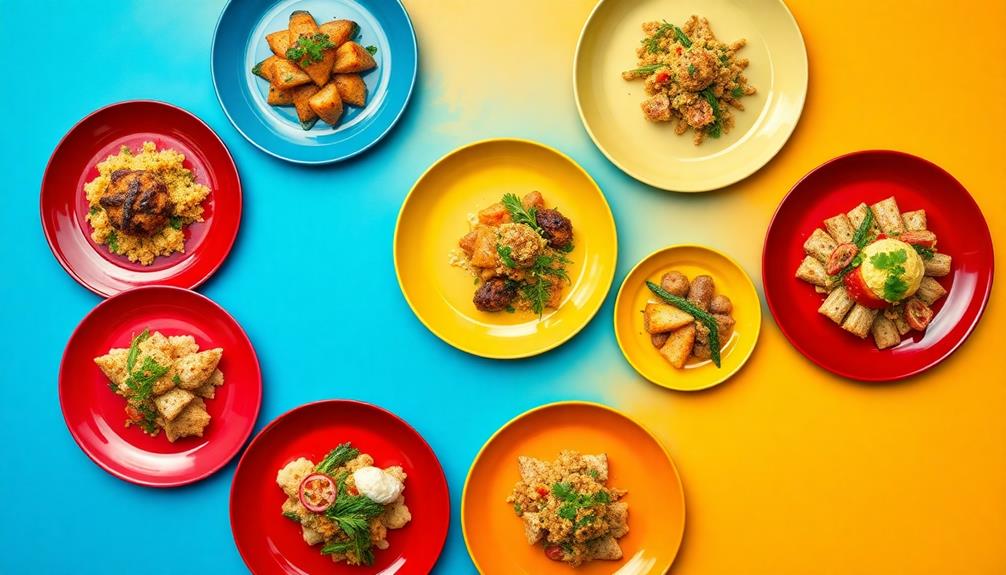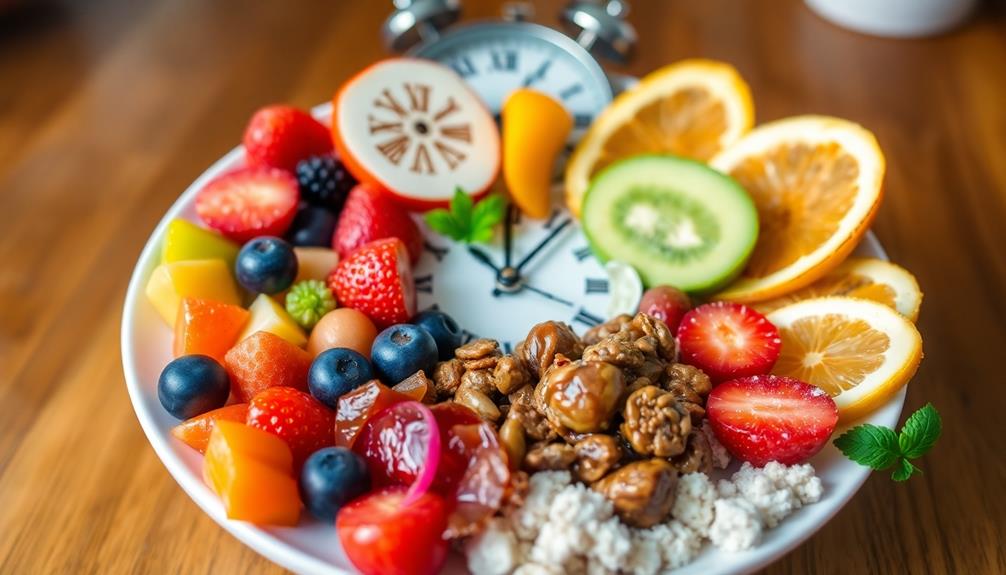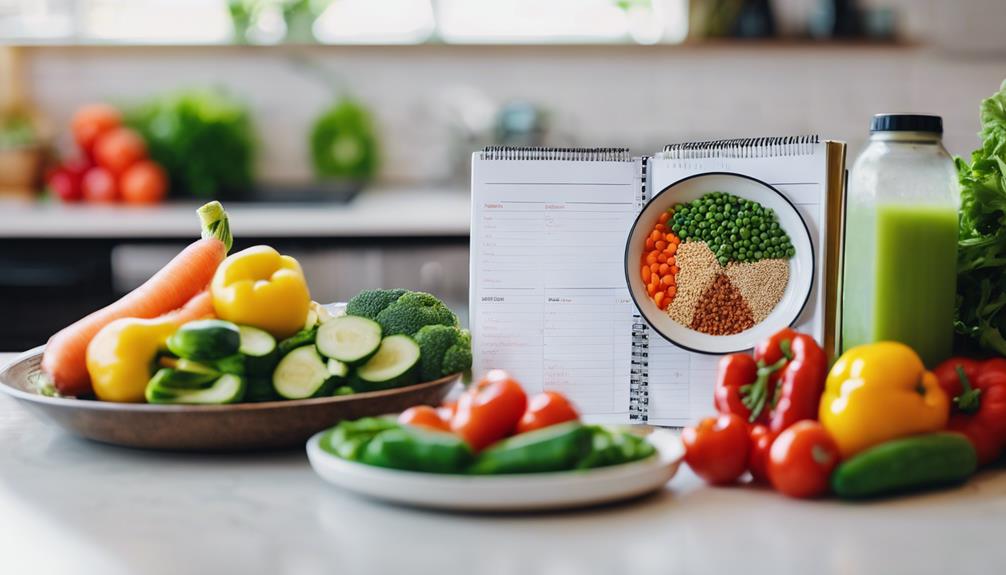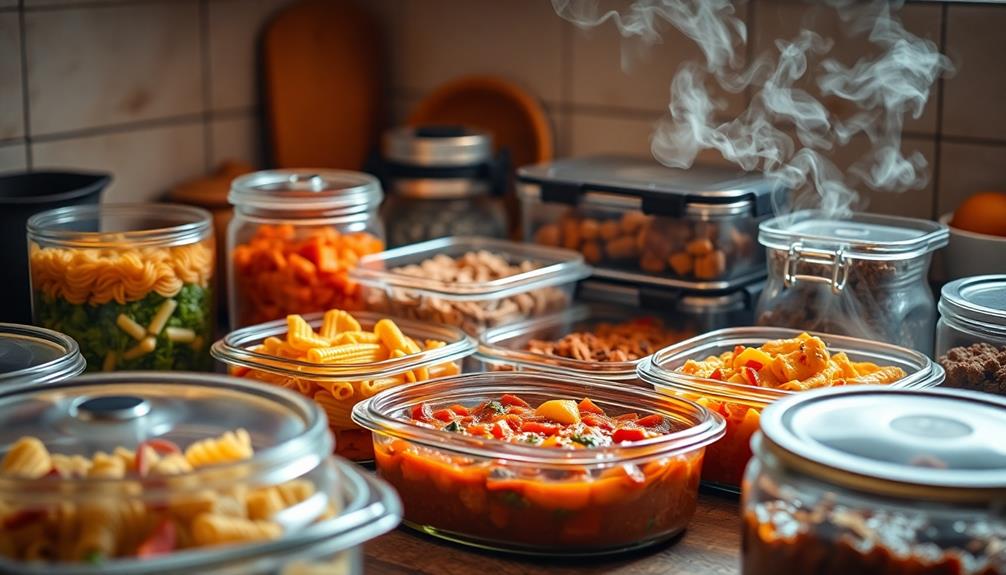The color of your plate can significantly impact how you taste food. Studies suggest that white plates may increase the perceived sweetness of desserts by up to 20%, making them more appealing. On the contrary, black plates tend to decrease enjoyment levels. The visual presentation, including color and shape, is crucial for food perception and overall satisfaction. This influence goes beyond just looks; it can also influence how much you want to eat. Recognizing these effects can enhance your dining experience, uncovering fascinating links between sight and taste. Dive into this intriguing connection and discover a whole new perspective on food enjoyment!
Key Takeaways
- Plate color significantly affects taste perception, with white plates enhancing sweetness and flavor intensity compared to darker colors.
- Desserts presented on white plates average an appetizing rating of 7.7, while black plates yield a lower rating of 5.0.
- High color contrast between food and plate enhances perceived freshness and can increase serving sizes by nearly 10%.
- Cultural influences shape aesthetic preferences, impacting how different plate colors are perceived in relation to food.
- Understanding the effects of plate color can help chefs optimize dish presentation and enhance overall dining experiences.
Understanding Taste Perception
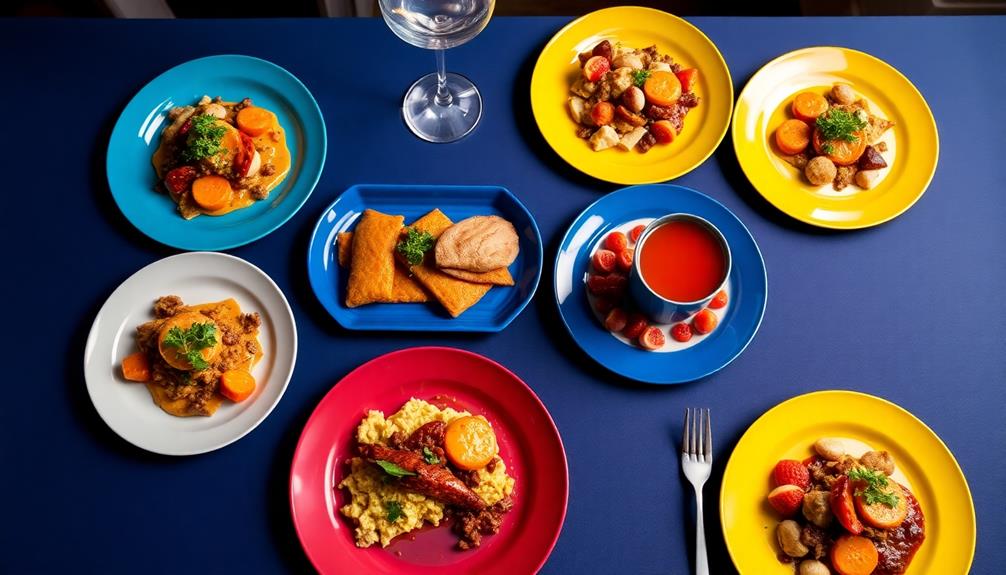
Taste perception goes beyond just the flavors in your food; it's also shaped by what you see. When you sit down to enjoy desserts, the presentation plays a vital role in how you perceive their taste. This concept can be likened to how the rich flavors of dishes like Red-Braised Pork Belly are enhanced by their presentation.
Studies show that the color of the plate can considerably influence your perception of sweetness. For instance, desserts served on white plates often receive higher sweetness ratings—up to 20% more—compared to those on black plates.
This influence of plate color extends to your overall enjoyment and judgment of food quality. When you see desserts presented on black square plates, they might seem more sophisticated, yet the perceived sweetness diminishes. Visual cues, like color intensity, also correlate strongly with flavor intensity ratings, making the plating an essential aspect of your dining experience.
Next time you enjoy a dessert, consider how the plate's color is affecting your taste perception. It's fascinating how your senses interact, and understanding this connection can enhance your appreciation for meals. By acknowledging the influence of visual presentation on taste, you can elevate your dining experiences to new heights.
The Role of Plate Color
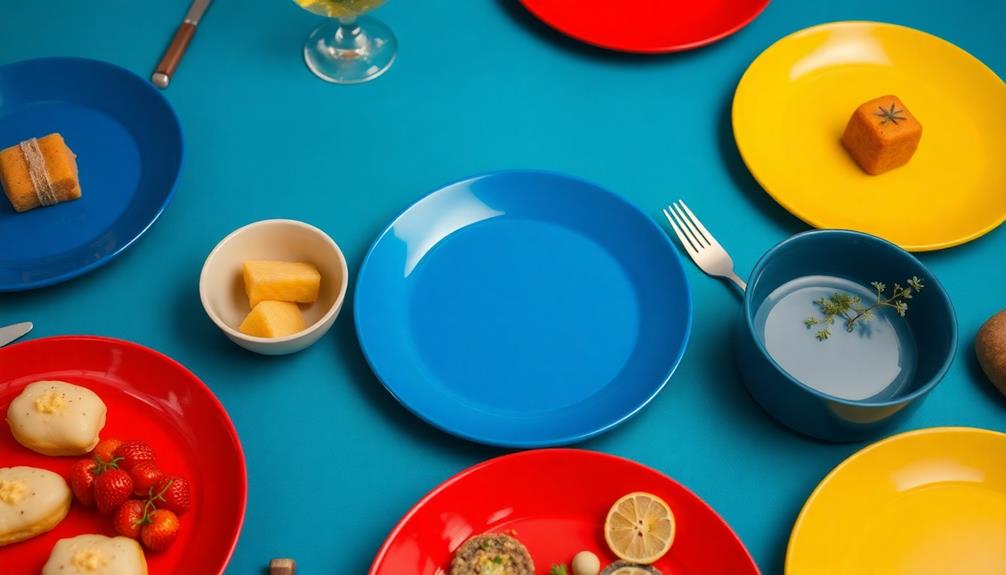
When you think about how food tastes, the color of the plate plays a significant role in your perception of flavor.
For instance, brightly colored plates can enhance the appeal of dishes like Caldeirada, making the vibrant colors of the seafood and spices pop, which may lead to a more enjoyable experience.
You mightn't realize it, but the visual appeal of your meal, influenced by plate color, can enhance or diminish your overall dining experience.
Plus, cultural aspects can shape your aesthetic preferences, adding another layer to how you enjoy your food.
Color and Flavor Perception
Studies show that the color of the plate you use can dramatically shape your flavor perception. For instance, desserts served on white plates often receive higher appetizing ratings compared to those on black plates. A study highlighted that Dessert A scored an average of 7.7 on a white plate, while it dropped to 5.0 on a black plate. This indicates a strong correlation between plate color and taste perception.
White plates can enhance perceived sweetness by about 20% and flavor intensity ratings by approximately 30%, especially for low-sugar desserts. These findings emphasize the significant role of visual presentation in shaping your sensory perception.
Here's a quick summary of the differences in dessert ratings based on plate color:
| Plate Color | Appetizing Rating | Flavor Intensity |
|---|---|---|
| White | 7.7 | High |
| Black | 5.0 | Low |
| White | Enhances Sweetness | +20% |
| Black | Reduces Sweetness | -20% |
Understanding how plate color influences consumer expectations can ultimately enhance your dining experience.
Visual Appeal and Experience
The visual appeal of a dish extends beyond just its ingredients; it encompasses the entire dining experience, prominently influenced by plate color. For instance, a beautifully arranged plate of Agnolotti can be visually enhanced by the choice of plate, making the handmade pasta even more enticing.
Studies reveal that the color of the plate markedly alters your perception of food, particularly desserts. When you enjoy a dessert on a white plate, it's rated as more appetizing—averaging 7.7 compared to just 5.0 on a black plate. This stark difference highlights how your experience can change based on visual cues.
White plates enhance perceived sweetness by about 20% and boost intensity ratings by 30%. In a study with 48 participants, those using white plates consistently rated desserts as sweeter than those on black plates.
The interaction between plate color and dessert type is essential, as it shapes overall flavor perception. High positive correlations between visual hedonic attributes and overall liking indicate that the aesthetics of plate color can elevate your satisfaction while dining.
Ultimately, the color of your plate plays a fundamental role in how you perceive the taste and enjoyment of your meal, transforming an ordinary dish into a delightful experience.
Cultural Influences on Aesthetics
Cultural influences shape not just what's on your plate, but also how the plate itself is viewed. Different cultural traditions dictate distinct plate designs and arrangements, impacting your dining experiences. For instance, Americans often favor center-right placements, while Japanese diners prefer center-bottom, and Italians choose bottom-right. These unique aesthetic choices reveal how cultural context affects food presentation.
Consider these emotional responses to plate design:
- Warmth: Colorful, patterned plates evoke feelings of joy and excitement, much like the vibrant presentation of a dish such as Mushroom Masala.
- Nostalgia: Traditional designs can remind you of cherished family gatherings.
- Elegance: Minimalistic, round white plates enhance sophistication and simplicity.
- Adventure: Unconventional colors spark curiosity and a willingness to try new dishes.
Round white plates, known to enhance sweetness, resonate differently across cultures due to varying associations with color perception. Chefs can harness these insights, tailoring plate colors and designs to cater to diverse consumer preferences.
Additionally, environmental factors, including the cultural context of dining, can shift how you perceive colors and shapes. By understanding these influences, you can elevate your dining experiences and truly appreciate the art of food presentation.
Aesthetic Appeal in Dining

Aesthetic appeal plays an essential role in dining experiences, affecting how you perceive taste and quality. The color of the plate can considerably influence food perception; for instance, desserts served on white plates often receive higher ratings than those on black plates. This preference underscores the importance of visual presentation. Research shows that white plates can enhance perceived sweetness and intensity, making desserts seem more enjoyable.
For example, traditional Indonesian desserts like Kue Putu and Dadar Gulung are often presented on vibrant plates to highlight their colors and textures.
Moreover, the aesthetic appeal of plate design can evoke emotional responses, leading to positive feelings that correlate with tastiness and quality. Contrast effects also play a vital role in serving sizes—high contrast can lead to larger servings, while low contrast often results in less food. This visual impact directly influences customer satisfaction, as appealing presentations can enhance your overall dining experience.
Chefs can optimize food presentation by carefully selecting plate colors and designs, ultimately boosting dessert ratings and increasing enjoyment. By understanding the connection between plate color and food perception, you can appreciate how these elements come together to create a memorable meal.
Impact of Plate Shape

When it comes to dining, plate shape can dramatically alter your perception of taste. You mightn't realize it, but the plates you choose can influence your enjoyment of food in surprising ways.
For instance, round plates often enhance the sweetness of desserts, making them more appealing. This effect can be particularly interesting when serving festive dishes like Graveyard Taco Dip, where the presentation is key to enjoyment.
Here are four ways plate shape impacts your dining experiences:
- Sweetness Boost: Round plates can increase perceived sweetness by about 20%, especially for low-sugar desserts.
- Quality Ratings: Desserts on black square plates receive higher quality ratings compared to those on white square plates.
- Familiarity Matters: Round plates are more commonly associated with positive dining experiences, leading to better overall quality ratings.
- Color Interaction: The combination of plate shape and color can further influence taste perception, enhancing or dampening flavor expectations.
Cultural Influences on Plating
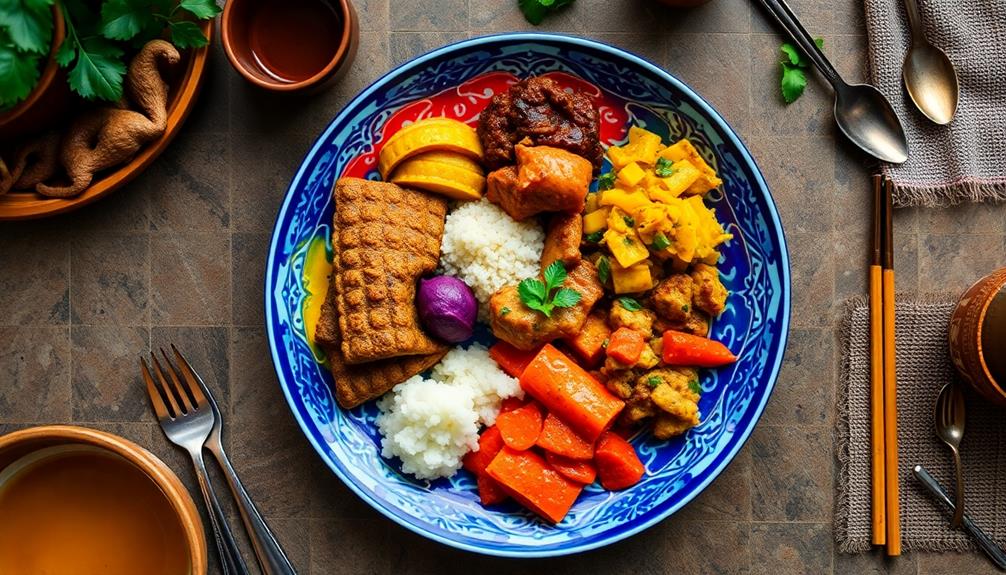
Plate shape isn't the only factor that plays a role in how you perceive food; cultural influences also shape the way dishes are presented. Cultural traditions dictate plate design, with specific colors and patterns reflecting various cuisines. For instance, floral patterns are common in Asian plating styles, while other cultures have their unique preferences.
You might notice that Americans often place food in the center-right of plates, whereas Japanese diners prefer the center-bottom, and Italians lean towards the bottom-right. These food placements reveal diverse cultural aesthetics that directly affect your taste perception.
In Greek cuisine, for example, the rustic presentation of dishes like Horiatiko Psomi emphasizes simplicity and authenticity, enhancing the overall dining experience. The balance in plating is essential for enhancing consumer pleasure; cultural perceptions of symmetry and order can shape your plating preferences.
Chefs use plates as canvases, adapting their food presentation to align with these cultural expectations. Additionally, studies show that cultural variations influence how you react to "offensive" cues in food placement, highlighting the importance of aesthetic choices in plating.
Ultimately, understanding these cultural influences can enhance your dining experience, making you more aware of how presentation impacts your overall enjoyment of a meal.
Experimental Findings Overview
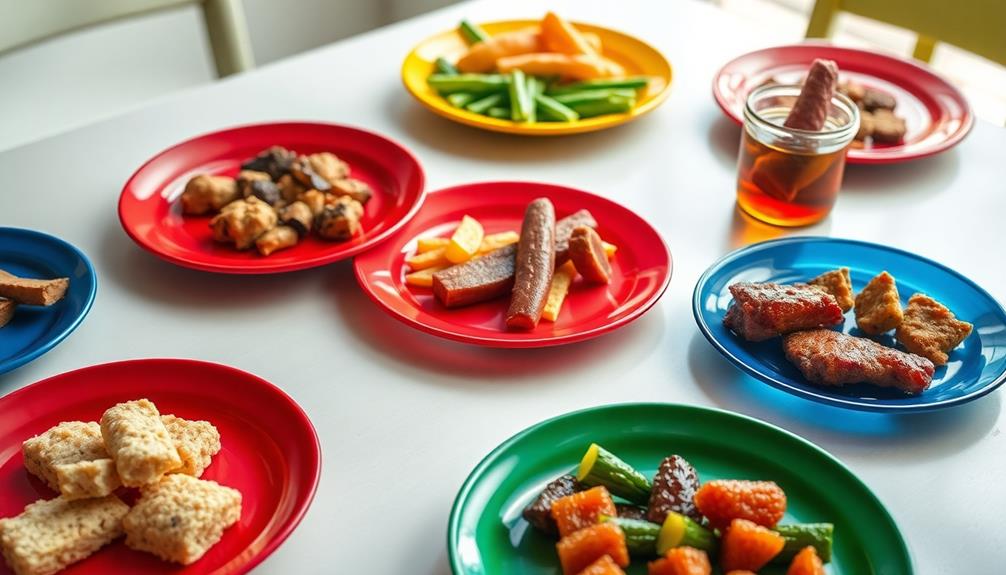
In exploring how plate color impacts your perception of taste, you'll find some intriguing results.
Studies suggest that the visual presentation of dishes, such as those from diverse culinary traditions like Asian Cuisine, can greatly influence our taste perception.
For instance, desserts served on white plates often seem more appetizing than those on black plates, but this effect varies with dessert type.
Understanding these nuances can really enhance your dining experience and enjoyment.
Plate Color Impact
How does the color of a plate influence your perception of food? Research shows that plate color markedly impacts your experience, especially with desserts. For instance, desserts served on white plates received an average appetizing rating of 7.7, while those on black plates averaged only 5.0. This stark contrast demonstrates the strong influence of plate color on food perception.
The same principle can apply to savory dishes found in diners, such as a Loaded Baked Potato or a Chef's Salad, where the visual presentation can enhance the overall dining experience.
Here are four emotional takeaways about plate color's impact:
- Visual Appeal: A bright plate can make your dessert look more inviting.
- Enhanced Sweetness: White plates can boost sweetness ratings by about 20%, making treats even more delightful.
- Flavor Perception: The intensity of flavors can change based on the plate, altering your enjoyment.
- Chef's Canvas: Chefs can use color contrast to enhance customer enjoyment and satisfaction.
These findings reveal that plate color plays a pivotal role in presentation ratings and overall food perception.
Dessert Type Variability
The impact of plate color varies not just by color itself but also by the type of dessert being served. For instance, traditional Japanese confections like Dorayaki (Red Bean Pancake) may evoke different responses based on their presentation.
In a recent study, dessert A received a higher appetizing rating on a white plate (M = 7.7) compared to a black plate (M = 5.0), showcasing notable differences in perception based on dessert type and plate color. Dessert C followed a similar trend, rated more appealing on a white plate (M = 7.4) than on a black plate (M = 6.8).
However, dessert B was preferred on a black plate (M = 7.5) over a white plate (M = 6.8), illustrating that not all desserts react similarly to plate color.
Flavor intensity ratings further emphasized these notable interactions. The perceived sweetness of desserts varied based on both plate color and the specific dessert served. Chocolate mousse, for example, was rated as sweeter on white plates compared to darker ones, highlighting the subtle psychological influence of presentation. Interestingly, these sensory perceptions were further modulated by the impact of oils on flavor, as certain desserts with higher fat content seemed to amplify the sweetness when paired with visually contrasting plate colors. This interplay between visual cues and ingredient composition underscores the complexity of flavor perception.
Visual Presentation Effects
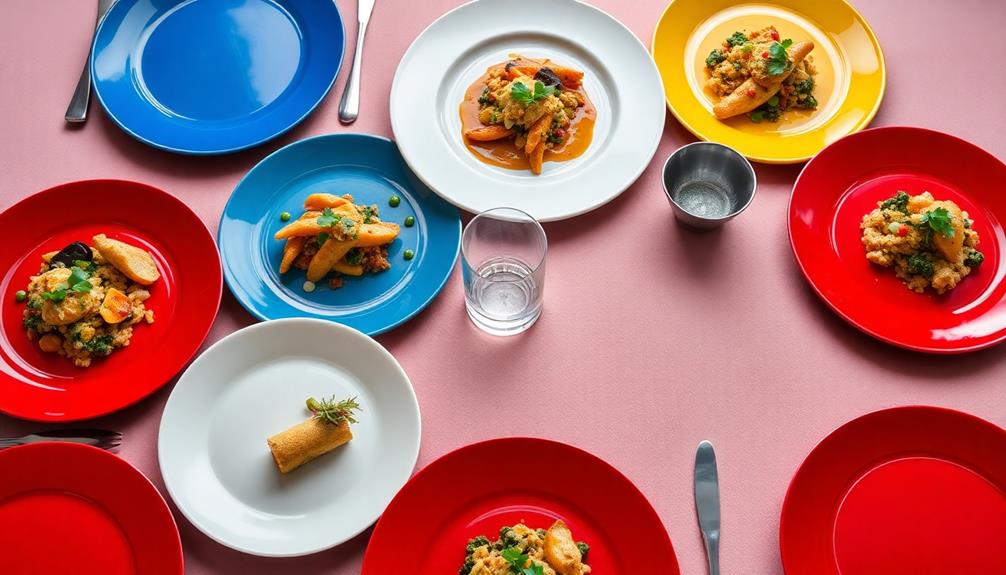
When you sit down to enjoy a meal, the visual presentation of the food plays an essential role in your overall experience. The color of the plate can notably influence food perception, affecting everything from dessert ratings to flavor intensity.
Here are four ways visual presentation impacts your dining experience:
- Aesthetic Appeal: Desserts on white plates score higher in appetizing ratings than those on black plates, like Dessert A's 7.7 versus 5.0.
- Sweetness Perception: White round plates can enhance sweetness ratings by approximately 20%, transforming your perception of flavors.
- Serving Size Influence: High color contrast between food and plate can increase serving sizes by 9.8%, while lower contrast decreases them by 13.5%.
- Overall Satisfaction: The right plate color enhances customer satisfaction, making every bite more enjoyable.
These elements of visual presentation shape your sensory experiences, showing that the aesthetic aspects of plate color matter more than you might think.
The next time you dine, consider how the colors surrounding your food influence not just how it looks but also how you taste it.
Practical Implications for Chefs

Understanding the impact of plate color on taste perception can greatly elevate your culinary creations. As a chef, you can markedly influence the perception of food by choosing the right plate color.
For instance, serving desserts on white round plates can enhance sweetness ratings by about 20% compared to black plates. If you're presenting overly sweet dishes, consider using black square plates, as they can boost perceptions of quality and liking.
Visual appeal plays an essential role in how your dishes are perceived. One study found that a dessert rated 7.7 on a white plate was considered more appetizing than a 5.0 on a black plate.
High color contrast between the plate and food not only enhances visual appeal but also encourages larger serving sizes—research indicates a 9.8% increase in self-serving amounts when using high contrast presentations.
Future Research Directions
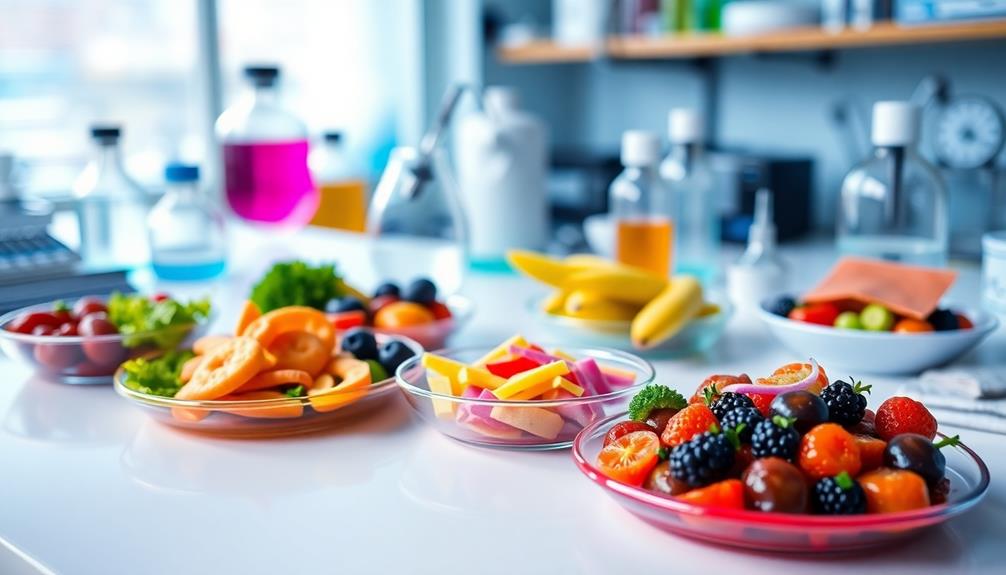
As chefs harness the influence of plate color on taste perception, it's important to contemplate what future research can uncover about this fascinating interaction. By delving deeper into the psychological interactions at play, we can better understand how plate color shapes our experience of food.
Here are some exciting directions for future studies:
- Investigate specific mechanisms: Explore how plate color alters taste perception through sensory and psychological processes.
- Examine plate shapes: Assess how different plate shapes, in conjunction with color, impact consumer judgments of food.
- Broaden food types: Expand studies to include various food types and cultural contexts, ensuring findings are applicable across diverse dining experiences.
- Utilize neuroimaging techniques: Leverage advanced neuroimaging methods to uncover the cognitive processes and emotional responses evoked by plate aesthetics during meals.
These avenues of research can enhance our understanding of flavor expectations and preferences over time, ultimately refining how we experience food.
Frequently Asked Questions
How Does Color Affect the Perception of Taste?
Color greatly affects your taste perception. Bright or vibrant colors often enhance sweetness and appeal, while darker shades might create different expectations. Your brain associates specific colors with flavors, influencing how you experience food.
How Does the Color of the Plate Affect Your Food Presentation?
The color of your plate greatly impacts food presentation. Using contrasting colors makes portions appear larger and more appealing, while white plates enhance the perceived attractiveness of your dishes, making them more appetizing to your guests.
Does the Color of Your Plate Affect How Much You Eat?
Yes, the color of your plate does affect how much you eat. High contrast colors can make you serve more, while low contrast colors might trick you into thinking you've got enough, leading to smaller portions.
Conclusion
So, the next time you sit down for a meal, remember: it's not just the food that matters, but the color of your plate. Who knew that a simple shade could elevate your dining experience? It's almost laughable that something so seemingly trivial could influence your taste buds so profoundly. Yet, here we are, letting the aesthetics dictate our enjoyment. Maybe it's time to rethink your dinnerware—or just embrace the irony and enjoy your meal, no matter the hue!

